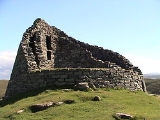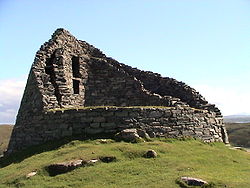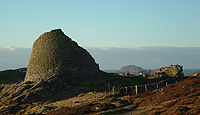
Dun Carloway
Encyclopedia


Broch
A broch is an Iron Age drystone hollow-walled structure of a type found only in Scotland. Brochs include some of the most sophisticated examples of drystone architecture ever created, and belong to the classification "complex Atlantic Roundhouse" devised by Scottish archaeologists in the 1980s....
situated in the district of Carloway
Carloway
Carloway is a district situated in the parish of Uig on the west coast of the Isle of Lewis, in the Outer Hebrides. The district has a population of around 500.- The District :...
, on the west coast of the Isle of Lewis, Scotland
Scotland
Scotland is a country that is part of the United Kingdom. Occupying the northern third of the island of Great Britain, it shares a border with England to the south and is bounded by the North Sea to the east, the Atlantic Ocean to the north and west, and the North Channel and Irish Sea to the...
. It is a remarkably well preserved broch - on the east side parts of the old wall still reaches to 9 metres tall. In places there are also more modern repairs to the east wall. Dun Carloway was probably built some time in the 1st century BC, and radiocarbon dating
Radiocarbon dating
Radiocarbon dating is a radiometric dating method that uses the naturally occurring radioisotope carbon-14 to estimate the age of carbon-bearing materials up to about 58,000 to 62,000 years. Raw, i.e. uncalibrated, radiocarbon ages are usually reported in radiocarbon years "Before Present" ,...
evidence from remains found in the broch show that it was last occupied around 1300 AD. At the base the broch is around 14 to 15 metres in diameter and the walls around 3 metres thick. It has a circular plan and hollow walls and was built without mortar. It probably had wooden floors, internal partitions and a thatched roof, necessary to make it habitable, but the only remaining evidence of this are post-holes. Together with the roof, the narrow passageway presumably secured by a wooden door, were the most vulnerable points of the building, especially to fire.

